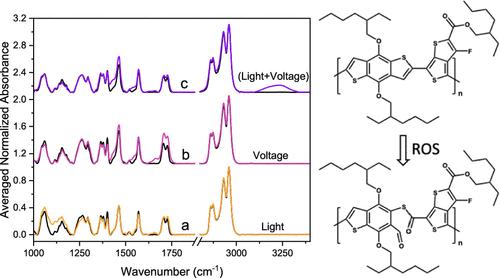大气暴露下pptb7的电压诱导降解及同时光暴露的贡献
IF 3.2
3区 化学
Q2 CHEMISTRY, PHYSICAL
引用次数: 0
摘要
以前对有机半导体(OSC)降解的研究主要集中在光化学过程上,这被认为是缩短器件寿命的主要原因。然而,OSC光电器件通过电荷产生、通过有源层材料的电荷迁移和/或电荷重组来工作,这需要在器件上存在电场来进行电荷收集或注入。这些装置中移动电荷的存在意味着极化子形式存在于盐碳中,其化学反应活性可能与中性盐碳大不相同。尽管电场在产生、收集和动员盐盐活性层中的载流子中起着至关重要的作用,但这些电荷对盐盐降解的贡献尚未得到很好的理解。本文利用红外反射-吸收光谱和x射线光电子能谱研究了器件电压对聚[[4,8-二[(2-乙基己基)氧]苯并[1,2-b:4,5-b ']二噻吩-2,6-二基][3-氟-2-[(2-乙基己基)羰基]噻吩[3,4-b]噻吩二基](PTB7)薄膜OSC降解的影响。研究人员提出,在黑暗环境大气条件下,在薄膜OSCs上施加电压,再加上大气中O2的掺杂,会导致超氧阴离子的产生,这些阴离子通过不同于单线态氧占主导地位的纯光降解过程的途径降解薄膜。同时暴露于(光+电压)下的PBT7薄膜拥有两种活性氧,其初始降解途径显然指向由施加电压产生的更具活性的极化子位点。这些结果表明,在理解opv的降解过程时,必须考虑外加电压的影响。本文章由计算机程序翻译,如有差异,请以英文原文为准。

Voltage-Induced Degradation of PTB7 with Atmospheric Exposure and the Contributions of Simultaneous Exposure to Light
Previous studies of organic semiconductor (OSC) degradation have focused primarily on photochemical processes, which are thought to be the main cause of shortened device lifetimes. However, OSC optoelectronic devices operate through charge generation, charge mobility through the active layer material, and/or charge recombination that require the presence of an electric field across the device for charge harvesting or injection. The presence of moving charges in these devices implies the presence of polaron forms in the OSC that may have vastly different chemical reactivity than the neutral OSC. Despite the critical role of the electric field in generating, collecting, and mobilizing charge carriers in OSC active layers, the contributions that these charges make to OSC degradation is not well understood. The role of device voltage as a contributor to OSC degradation is studied here for films of poly[[4,8-bis[(2-ethylhexyl)oxy] benzo[1,2-b:4,5-b′]dithiophene-2,6-diyl][3-fluoro-2-[(2-ethylhexyl)carbonyl]thieno[3,4-b]thiophenediyl]] (PTB7) using infrared reflectance–absorbance spectroscopy and X-ray photoelectron spectroscopy. It is proposed that the application of voltage across thin film OSCs under dark ambient atmosphere conditions, in combination with doping by atmospheric O2, leads to the generation of superoxide anions that degrade the film through pathways different from those of purely photodegradative processes in which singlet oxygen is proposed to be the predominant player. PBT7 films exposed simultaneously to (light + voltage) host both reactive oxygen species with initial degradation pathways apparently directed to the more reactive polaron sites generated by the applied voltage. These results demonstrate that the effects of applied voltage must be considered when understanding degradation processes in OPVs.
求助全文
通过发布文献求助,成功后即可免费获取论文全文。
去求助
来源期刊

The Journal of Physical Chemistry C
化学-材料科学:综合
CiteScore
6.50
自引率
8.10%
发文量
2047
审稿时长
1.8 months
期刊介绍:
The Journal of Physical Chemistry A/B/C is devoted to reporting new and original experimental and theoretical basic research of interest to physical chemists, biophysical chemists, and chemical physicists.
 求助内容:
求助内容: 应助结果提醒方式:
应助结果提醒方式:


